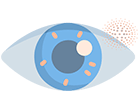Shiels, A., & Hejtmancik, J. F. (2017). Mutations and mechanisms in congenital and age-related cataracts. Experimental eye research, 156, 95–102. https://doi.org/10.1016/j.exer.2016.06.011
Li, J., Chen, X., Yan, Y., & Yao, K. (2020). Molecular genetics of congenital cataracts. Experimental eye research, 191, 107872. https://doi.org/10.1016/j.exer.2019.107872
Shiels, A., & Hejtmancik, J. F. (2019). Biology of Inherited Cataracts and Opportunities for Treatment. Annual review of vision science, 5, 123–149. https://doi.org/10.1146/annurev-vision-091517-034346
Ceyhan, D., Schnall, B. M., Breckenridge, A., Fontanarosa, J., Lehman, S. S., & Calhoun, J. C. (2005). Risk factors for amblyopia in congenital anterior lens opacities. Journal of American Association for Pediatric Ophthalmology and Strabismus, 9(6), 537-541. doi:10.1016/j.jaapos.2005.09.001
Cassidy, L., & Taylor, D. (1999). Congenital cataract and multisystem disorders. Eye, 13(3), 464-473. doi:10.1038/eye.1999.123
Ma, A. S., Grigg, J. R., Ho, G., Prokudin, I., Farnsworth, E., Holman, K., Cheng, A., Billson, F. A., Martin, F., Fraser, C., Mowat, D., Smith, J., Christodoulou, J., Flaherty, M., Bennetts, B., & Jamieson, R. V. (2016). Sporadic and Familial Congenital Cataracts: Mutational Spectrum and New Diagnoses Using Next-Generation Sequencing. Human mutation, 37(4), 371–384. https://doi.org/10.1002/humu.22948





